U n i v e r s i t é Y O R K U n i v e r s i t y
ATKINSON FACULTY OF LIBERAL AND PROFESSIONAL STUDIES
SCHOOL OF ANALYTIC STUDIES & INFORMATION TECHNOLOGY
S C I E N C E A N D T E C H N O L O G Y S T U D I E S
STS 3700B 6.0 HISTORY OF COMPUTING AND INFORMATION TECHNOLOGY
ATKINSON FACULTY OF LIBERAL AND PROFESSIONAL STUDIES
SCHOOL OF ANALYTIC STUDIES & INFORMATION TECHNOLOGY
S C I E N C E A N D T E C H N O L O G Y S T U D I E S
STS 3700B 6.0 HISTORY OF COMPUTING AND INFORMATION TECHNOLOGY
Lecture 16: The First Modern Computers
| Prev | Next | Search | Syllabus | Selected References | Home |
| 0 | 1 | 2 | 3 | 4 | 5 | 6 | 7 | 8 | 9 | 10 | 11 | 12 | 13 | 14 | 15 | 16 | 17 | 18 | 19 | 20 | 21 | 22 |
Topics
-
"The impact of computers is tremendous. Our lives are certainly influenced by these automatons, and our very production of consumer and defense goods is indirectly controlled by them. Our national defense is entrusted to them. Our inventories and stock keeping are controlled, our records are kept, our bookkeeping is performed by them. Our routine, tedious, and painfully repetitive mental effort is ameliorated by them. We are relieved of arduous mental tasks by them much the same as we were relieved of arduous manual tasks by powered machinery. We are on the threshold of a new era and computing machines are here to stay and play an ever greater part in this era."
Karl Kempf (1961) -
The last steps towards the 'modern' computer consisted in a number of less-known inventions, which paved the way
for the transition from the electromechanical to the electronic design.
"With some exceptions—including Babbage's purely mechanical engines, and the finger-powered National Accounting Machine—early digital computing machines were electromechanical. That is to say, their basic components were small, electrically-driven, mechanical switches called 'relays.' These operate relatively slowly, whereas the basic components of an electronic computer—originally vacuum tubes (valves)—have no moving parts save electrons and so operate extremely fast […] Relays were too slow and unreliable a medium to make practicable the construction of a large-scale general-purpose digital computer (notwithstanding valiant efforts in this direction by Aiken). It was the development of high-speed digital techniques using vacuum tubes that made the modern computer possible."
[ from The Modern History of Computing ] -
Already in 1898 Valdemar Poulsen had invented a magnetic wire on which data can be recorded. In fact, "he built and patented the
first working magnetic recorder called the Telegraphone with wire wrapped around a drum and a recording/playback head
that moved by a screw thread on top." [ see Magnetic Recording History Pictures ]
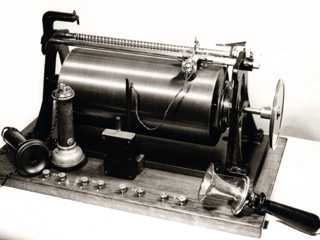
Poulsen Telegraphone, 1898 (from EMTEC)
This is a very important invention because later this principle will be used for magnetic tapes and consequently magnetic drums and platters. In 1928 Fritz Pleumer patented his magnetic tape. And in the same year the punched card with 45 holes was replaced by one with 80 holes. Because IBM, which by then had become the most important manufacturer of computing devices and peripherals, marked the 80 columns card as a standard, it rapidly became the industry standard.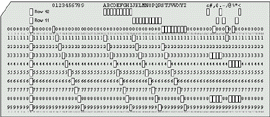
IBM Punched Card with 80 Columns
In 1932 G Taushek, starting from Pleumer's ideas introduced the first magnetic drum. The device consists of a ferromagnetic sheet wrapped around a rotating metal cylinder. Several read/write heads, mounted just a few millimeters from each other, detect and produce electromagnetic pulses. The pulses are 'memorized' on the sheet by the magnetic arrangement of the metal particles.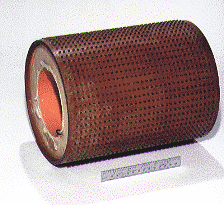
Taushek's Magnetic Drum
In the first prototype, the capacity of a 20 x 10 cm sheet was 500,000 bits or (at 8 bits/byte) a little less than 64kB. -
"Designed and constructed in 1931 by Charles Eryl Wynn-Williams at the Cavendish Laboratory, Cambridge, the
scale-of-two counter was used to count sub-atomic particles in nuclear disintegration experiments. It was the first practical
digital electronic counting device, and played a crucial role in the development of nuclear physics. It opened the way to the
digital electronic computers developed during and after the Second World War." Jeff Hughes's interesting article on The Scale-of-Two Counter,
describes the context of the invention.
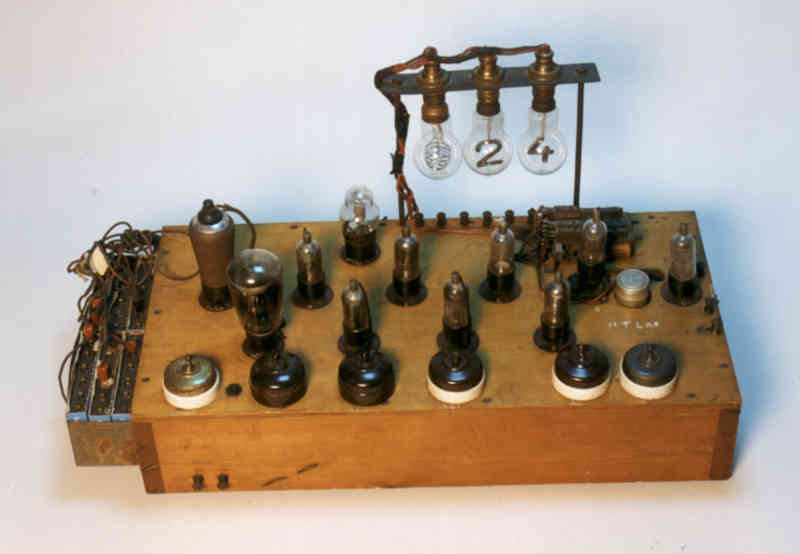
Scale of Two Counter at the Cavendish Laboratory, Cambridge
-
The notion and the applications of feedback have been around for a long time. See, for example,
F L Lewis, A Brief History of Feedback Control.
A feedback system is a a system which is capable of self-regulation on the basis of input from its environment. A classical
example is the thermostat in your home heating system.

The Feedback or Rigenerative Circuit
The specific application of the concept of negative and positive feedback to electronic circuits is due to several people. Perhaps the credit for its discovery should go to Edwin Howard Armstrong (1914 - 1954), who "showed how the amplified signal taken from the plate of the Audion could be used to strengthen the incoming signal, which then would be amplified and returned again to the incoming signal (grid of the tube) and so until the point of oscillation was almost reached. Suddenly the barriers to consistent long range radio communications were down. No longer was it necessary for the transmitter to actually power the earphones producing the sound. Now all the receiver required was a 'smell' of the signal and the receiver furnished the power. The Spark-generator transmitter meant a constant arc that consumed energy at a voracious rate and generated a broad band of radio frequencies that interfered with reception.""He enrolled in electrical engineering at Columbia, and in 1913, while still an undergrad, made his first great discovery, regeneration. At that time Lee De Forest's audion tube, the first triode vacuum tube, had been around for several years. No one had done much with it, though, because De Forest himself didn't understand how it worked and because it was a really poor amplifier. Armstrong discovered that the gain of a triode amplifier could be enormously increased by feeding some of the amplifier output back into the input, i.e. by using positive feedback. Given enough feedback, the amplifier became a stable and powerful oscillator, perfect for driving radio transmitters. Given a little less feedback, the amplifier became a more sensitive radio receiver than anything else at the time. Other people had come upon feedback at about the same time, but Armstrong characterized it and understood it in a way that made it practical for real use." [from Edwin Howard Armstrong ]
In 1932 a long dispute between De Forest and Armstrong resulted in the patent being assigned, probably unfairly, to De Forest. -
In 1937, at the now-famous Bell Labs, George R Stibitz
(1904-1995) "gathers together a conglomeration of old relays, batteries, flashlight bulbs, wires and tin strips…The result
was the prototype binary adder circuit—an electromechanical circuit that controlled binary addition." [ from
George Stibitz ].
The prototype, aptly called K-Model, where 'K' stands for 'kitchen,' was then perfected until it was capable of performing
the basic mathematical functions, not only with real numbers, but also with complex numbers. It was finally renamed The
Complex Number Calculator and later The Bell Labs Model Relay Computer, and was considered by many
as the world's first electronic digital computer. "In 1940 Stibitz installed his invention at the company's main office in
Manhattan, linking it to three separate teletype machines within the same building, allowing the computer to be used from more
than one location. Nine months later he added a fourth teletype—250 miles away in New Hampshire."
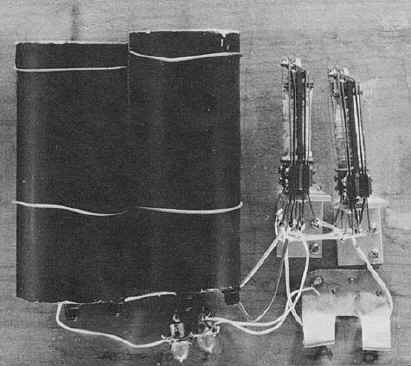
George Stibitz's K-Model
-
In 1937 Claude Elwood Shannon
(1916 - 2001) completed his master's thesis on machine logic at MIT, A Symbolic Analysis of Relay and Switching Circuits.
[ The full thesis is available as a large pdf file (16MB+) as one of the Handouts
in the course CNS188a at Caltech. ] The year after he published the main results in a separate article by the same title in Trans. of the AIEE, VoL 57 (1938), pp. 713-723.
(Shannon's thesis has since been described as: "Possibly the most important master's thesis of the twentieth century..")
Here is a short excerpt from the introduction:
Handouts
in the course CNS188a at Caltech. ] The year after he published the main results in a separate article by the same title in Trans. of the AIEE, VoL 57 (1938), pp. 713-723.
(Shannon's thesis has since been described as: "Possibly the most important master's thesis of the twentieth century..")
Here is a short excerpt from the introduction:
"In the control and protective circuits of complex electrical systems it is frequently necessary to make intricate interconnections of relay contacts and switches… The method of attack on these problems may be decribed briefly as follows: any circuit is represented by a set of equations, the terms of these equations corresponding to the various relays and switches in the circuit. A calculus is developed for manipulating these equations by simple mathematical procedures… This calculus is shown to be exactly analogous to the calculus of propositions used in the symbolic study of logic."
In his article 1938: Binary Computer is Engineered, Grant Kien offers the following 'translation' into everyday language:"The main idea that Shannon picked up from Boole was that all human rational processes could be reduced to the three operative descriptors (now called Boolean Operators) AND, OR and NOT. Boole argued that our rational processes depend primarily of grouping together things by, for example, saying 'this thing AND that thing'. Similarly, we make decisions based on 'this thing OR that thing', and to make more specific selections, we say 'this thing NOT that thing'. This model of thought conceives of a pool of all possible choices, from which specific categories of things are chosen. For example, a person may choose all the candies with the descriptor 'red' from a bowl of assorted coloured candy mixed with chocolates. In this case, the rational process includes the descriptions 'candy' AND 'red'. By bringing together these two descriptors, only red candies may be selected from the container. If the person wants more than just red candy, they may choose the categories 'candy' AND 'red' OR 'orange', thus describing all the possible candies in the bowl they want. Conversely, if they don't want a specific kind of candy, but want all the rest, they may choose, for example, 'candy' NOT 'green'. This will give them everything in the bowl that is classified non-green candy. This distinction is important, because there is also something described as 'chocolate' in the bowl, which will also be excluded by default from their description, since it is a different category of thing."
For a more precise description of the AND, OR, NOT, etc. logic gates, see Logic Elements. Shannon’s article had a powerful impact and can be rightly considered one of the most crucial turning point in the development of modern computer science. "Shannon had provided electronics engineers with the mathematical tool they needed to design digital electronic circuits, and these techniques remain the cornerstone of digital electronic design to this day." -
We are now ready to consider the culmination of all these preliminary efforts. In the next lecture we will discuss some
of those machines which can be justly called digital computers in the modern sense of the term.
In preparation for that, please browse through the History of Computing Information,
a great collection of documents assembled by Mike Muuss. In particular read through
 The ENIAC Story by Martin H. Weik (1961).
The ENIAC Story by Martin H. Weik (1961).
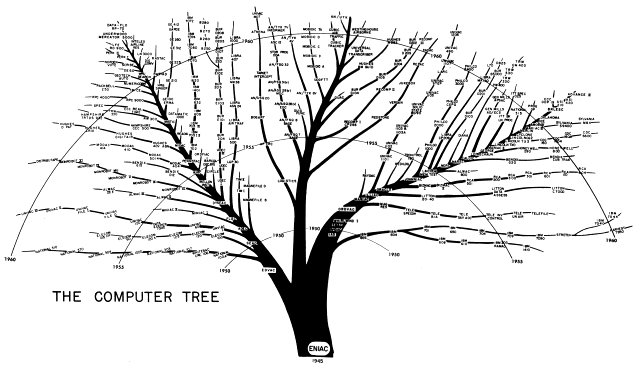
The Computer Tree (1961)
[ For a larger, clearer image, click here ]"In the accompanying graphical representation of the computer tree the trunk rests on the ENIAC. The serial computers, represented by EDVAC, and the parallel computers, represented by the ORDVAC, are shown as separate limbs. This separation tends to distinguish the business computers on the left limb from the scientific computers on the right limb. The computers which were developed specifically to meet military needs are shown on the center limb. Manufacturers have entered the electronic computer field at different times, shown as various branches. Only university and government sponsored computers are shown along the limbs. The radial distance from the ENIAC is an approximate indication of the year each computer was developed, constructed, or placed in operation." [ from Electronic Computers within the Ordnance Corps: Historical Monograph from 1961 ]
Readings, Resources and Questions
-
Even as the first digital computers started making their appearance, and just as Ada Lovelace had
already done some hundred years before, scientists and engineers began to speculate on the possible
future of computers. Read one such famous article,
 As We May Think,
by Vannevar Bush (1890 - 1974).
As We May Think,
by Vannevar Bush (1890 - 1974).
© Copyright Luigi M Bianchi 2001, 2002, 2003
Picture Credits: S E Schoenherr · Westminster U · Ricky Spelta · Mike Muuss
Last Modification Date: 11 April 2003
Picture Credits: S E Schoenherr · Westminster U · Ricky Spelta · Mike Muuss
Last Modification Date: 11 April 2003